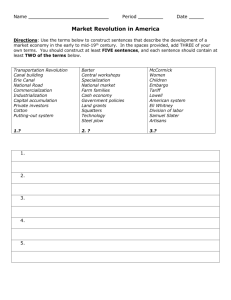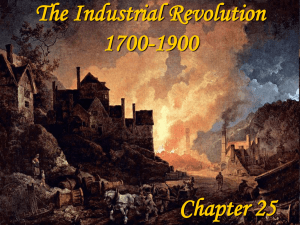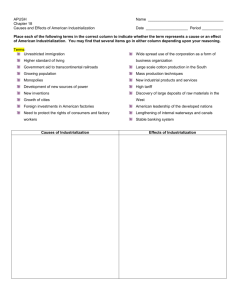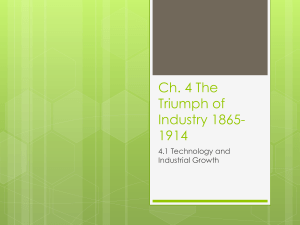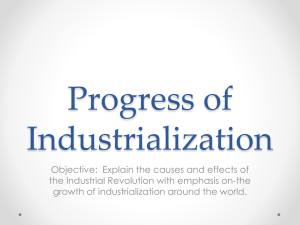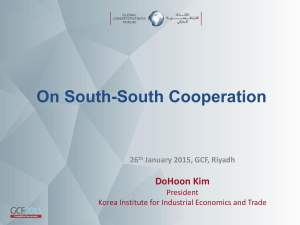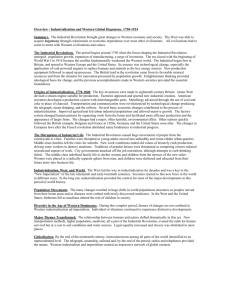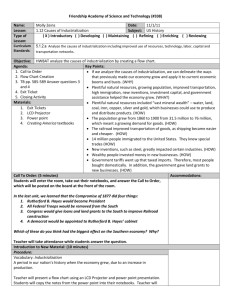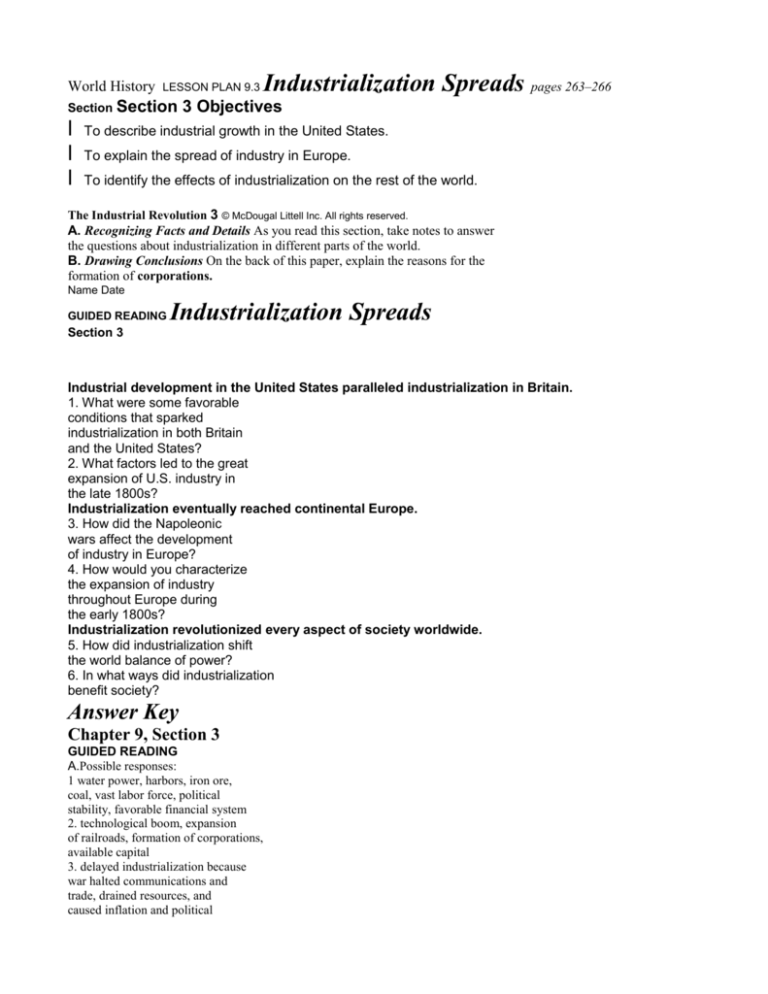
World History
LESSON PLAN 9.3
Section Section
Industrialization Spreads pages 263–266
3 Objectives
l1 To describe industrial growth in the United States.
l2 To explain the spread of industry in Europe.
l3 To identify the effects of industrialization on the rest of the world.
The Industrial Revolution 3 © McDougal Littell Inc. All rights reserved.
A. Recognizing Facts and Details As you read this section, take notes to answer
the questions about industrialization in different parts of the world.
B. Drawing Conclusions On the back of this paper, explain the reasons for the
formation of corporations.
Name Date
GUIDED READING
Industrialization Spreads
Section 3
CHAPTER
9
Industrial development in the United States paralleled industrialization in Britain.
1. What were some favorable
conditions that sparked
industrialization in both Britain
and the United States?
2. What factors led to the great
expansion of U.S. industry in
the late 1800s?
Industrialization eventually reached continental Europe.
3. How did the Napoleonic
wars affect the development
of industry in Europe?
4. How would you characterize
the expansion of industry
throughout Europe during
the early 1800s?
Industrialization revolutionized every aspect of society worldwide.
5. How did industrialization shift
the world balance of power?
6. In what ways did industrialization
benefit society?
Answer Key
Chapter 9, Section 3
GUIDED READING
A.Possible responses:
1 water power, harbors, iron ore,
coal, vast labor force, political
stability, favorable financial system
2. technological boom, expansion
of railroads, formation of corporations,
available capital
3. delayed industrialization because
war halted communications and
trade, drained resources, and
caused inflation and political
instability
4. Industrialization was regional
rather than nationwide; some
countries did not industrialize
because of geographic or social
obstacles.
5. widened existing inequalities
between industrialized and nonindustrialized
countries and
paved the way for imperialism
6. created opportunities for achieving
wealth, a comfortable standard
of living, education, a higher
life expectancy, and democratic
and social reforms
B. Possible response: Corporations
were formed to raise capital and
increase profits by encouraging
people to invest in business ventures
that reduced their financial
risks.
The Industrial Revolution 115 © McDougal Littell Inc. All rights reserved.
Name Date
SECTION QUIZ
Industrialization Spreads
Section 3
A. Terms and Names If the statement is true, write “true” on the line. If it is
false, change the underlined word or words to make it true.
Example: Imperialism was a result of industrialization.________________________________
Example: The country where the Industrial Revolution began was the
United States. ________________________________________________________
1. The region of the United States that first underwent significant industrialization
was the Midwest. ______________________________________________________________
2. In the United States, the Industrial Revolution began with the industrialization
of the railroad industry.__________________________________________________________
3. The country of Belgium led Europe in adopting the industrial technology of Britain.
____________________________________________________________________________
4. The French Revolution and the Napoleonic Wars accelerated the process of
industrialization in Europe. ______________________________________________________
5. Being blockaded during the War of 1812 encouraged France to use its own resources
to develop independent industries. ________________________________________________
6. A corporation is a type of business owned by stockholders who share in its profits but
are not personally responsible for its debts.__________________________________________
7. In the 19th century, industrialization had the effect of closing the gap between
industrialized and non-industrialized countries. ______________________________________
8. Under Muhammad Ali’s rule, Turkey began to industrialize. __________________________
B. Critical Thinking Briefly answer the following question on the back of this paper.
What are some of the factors that discouraged the growth of industrialization in
certain European countries?
CHAPTER
9
true
England
Answer Key
Chapter 9, Section 3
SECTION QUIZ
Industrialization Spreads
A. 1. Northeast
2. textile
3. true
4. slowed
5. the United States
6. true
7. widening
8. Egypt
B. Possible answers:
a. British secrecy about the new
industrial technology
b. Disruptions caused by wars
such as the War of 1812, the
French Revolution, and the
Napoleonic wars
c. Political division
d. Isolated populations
e. Scattered resources
f. The existence of certain types
of social structures
g. Geographic obstacles to
transportation
h. Lack of natural resources
i. Lack of a large population of
workers
© McDougal Littell Inc. All rights reserved.
8 Unit 3, Chapter 9
Name Date
“The Opening of the
Liverpool to Manchester Railway”
PRIMARY SOURCE from
by Frances Ann Kemble
The railway connecting the port of Liverpool with the city of Manchester was
the first for which high-speed locomotives were designed. This excerpt, from
Frances Ann Kemble’s Some Recollections of a Girlhood, is an eyewitness account
of the opening of the Liverpool-Manchester Railway on September 15, 1830.
What were her impressions of this historic train ride?
Section 1
W
e started on Wednesday last, to the number
of about eight hundred people, in carriages.
The most intense curiosity and excitement prevailed,
and, though the weather was uncertain, enormous
masses of densely packed people lined the road,
shouting and waving hats and handkerchiefs as we
flew by them. What with the sight and sound of
these cheering multitudes and the tremendous
velocity with which we were borne past them, my
spirits rose to the true champagne height, and I
never enjoyed anything so much as the first hour of
our progress. I had been unluckily separated from
my mother in the first distribution of places, but by
an exchange of seats which she was enabled to
make she rejoined me when I was at the height of
my ecstasy, which was considerably damped by
finding that she was frightened to death. . . . While
I was chewing the cud of this disappointment . . .
a man flew by us, calling out through a speakingtrumpet
to stop the engine, for that somebody in
the directors’ carriage had sustained an injury.
We were all stopped accordingly, and presently a
hundred voices were heard exclaiming that Mr.
Huskisson was killed; the confusion that ensued is
indescribable; the calling out from carriage to carriage
to ascertain the truth, the contrary reports
which were sent back to us, the hundred questions
eagerly uttered at once, and the repeated and
urgent demands for surgical assistance, created a
sudden turmoil that was quite sickening. At last we
distinctly ascertained that the unfortunate man’s
thigh was broken. From Lady Wilton, who was in
the Duke’s carriage, and within three yards of the
spot where the accident happened, I had the following
details, the horror of witnessing which we
were spared through our situation behind the great
carriage. The engine had stopped to take in a supply
of water, and several of the gentlemen in the
directors’ carriage had jumped out to look about
them. Lord Wilton, Count Batthyany, Count
Matuscenitz, and Mr. Huskisson among the rest
were standing talking in the middle of the road,
when an engine on the other line, which was parading
up and down merely to show its speed, was
seen coming down upon them like lightning. The
most active of those in peril sprang back into their
seats; Lord Wilton saved his life only by rushing
behind the Duke’s carriage, and Count Matuscenitz
had but just leaped into it, with the engine all but
touching his heels as he did so; while poor Mr.
Huskisson, less active from the effects of age and
ill-health, bewildered, too, by the frantic cries of
‘Stop the engine! Clear the track!’ that resounded
on all sides, completely lost his head, looked helplessly
to the right and left, and was instantaneously
prostrated by the fatal machine, which dashed
down like a thunderbolt upon him, and passed over
his leg, smashing and mangling it in the most horrible
way. (Lady Wilton said she distinctly heard the
crushing of the bone.) So terrible was the effect
of the appalling accident that, except that ghastly
‘crushing’ and poor Mrs. Huskisson’s piercing
shriek, not a sound was heard or a word uttered
among the immediate spectators of the catastrophe.
from Frances Ann Kemble, Some Recollections of a
Girlhood (1878). Reprinted in John Carey, ed., Eyewitness
to History (New York: Avon Books, 1987), 304–305.
Discussion Questions
Recognizing Facts and Details
1. How many people rode on the first train ride on
the Liverpool-Manchester Railway?
2. What happened to William Huskisson?
3. Making Inferences Based on your reading
of this excerpt, how do you know that the
Liverpool–Manchester Railway was an important
improvement in transportation during the
Industrial Revolution?
CHAPTER
9
Chapter 9, Section 1
PRIMARY SOURCE
The Opening of the Liverpool to
Manchester Railway
Possible responses:
1. about 800
2. During a routine stop, he left
the train and was hit by a train
traveling in the opposite direction.
As a result of the accident,
his thigh was badly broken.
3. because the train was packed
with dignitaries, including
English nobility; because crowds
gathered to observe the railway’s
inaugural ride

